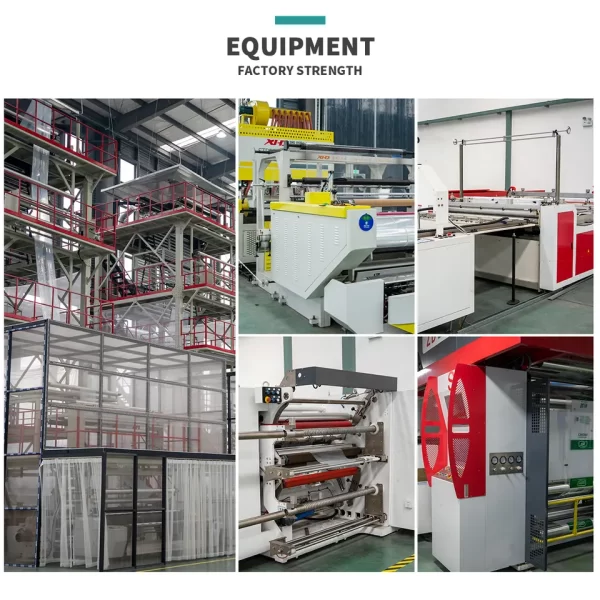The invaluable bond between polymer science and the blown film industry is a powerful testament to the fusion of science and industry. Polymer science, a branch of chemistry that deals with large molecules made up of repeating subunits, acts as the vital driving force of the blown film industry. This illuminating journey through the intricacies of polymer science’s role in the blown film sector provides a deep understanding of how these scientific principles are applied in an industrial setting.
Understanding Polymers: The Foundation Stones of Blown Film
Polymers, the core constituents for producing blown films, are essentially large molecules fashioned from smaller, repeating units known as monomers. When these monomers establish a bond in an orderly chain, they collectively form a polymer. The outcome is a substance that boasts properties far removed from the individual monomers that form it. A prime example is polyethylene, a frequently used polymer in blown film extrusion, born out of the linkage of multiple ethylene monomers.
Each polymer used in the blown film industry possesses its own set of characteristics, allowing us to achieve a variety of physical and mechanical properties in the final film. The choice of polymer directly influences the film’s strength, flexibility, transparency, and many other characteristics that are crucial to its end-use application.
Key Properties of Polymers: The Heartbeat of Blown Film Extrusion
There’s a plethora of polymer properties that significantly impact the qualities and performance of the finished blown film. Understanding these properties is key to controlling the production process and achieving the desired film characteristics.
Melting Point and Glass Transition Temperature
Every polymer has a unique melting point (Tm) and glass transition temperature (Tg). The Tm is the temperature at which a polymer changes from a solid to a liquid, while the Tg is the temperature at which a polymer transitions from a hard, brittle state to a soft, rubbery one. These thermal properties are crucial in determining the optimal process temperature in blown film extrusion. They provide a thermal window within which the extrusion process must operate to avoid issues such as thermal degradation or poor melt strength.
Crystallinity
Crystallinity in polymers denotes the degree of structural order. A highly crystalline polymer has a high proportion of orderly, tightly packed molecular chains. Conversely, an amorphous polymer lacks this order, with molecular chains arranged randomly. The level of crystallinity influences many of the film’s properties, including its mechanical strength, barrier properties, and optical clarity.
Melt Strength
The melt strength of a polymer is another vital property that refers to the ability of the molten polymer to resist deformation under stress. During the blown film extrusion process, the molten polymer is inflated into a bubble and needs to maintain its shape against the forces of gravity and internal pressure. A polymer with higher melt strength will yield a more stable bubble and more uniform film.
Rheology
Polymer rheology, the study of how these materials deform and flow under applied forces, is a fundamental aspect of blown film extrusion. It dictates how the polymer will behave when it’s heated, extruded through the die, inflated, and cooled. Understanding the rheological behavior of polymers is key to predicting and controlling the extrusion process, ensuring the production of high-quality films.
Common Polymer Types in Blown Film Extrusion and Their Attributes
The type of polymer chosen for blown film extrusion can significantly influence the characteristics of the final product. Several polymer types are commonly used, each with its unique strengths and applications.
Polyethylene (PE)
Polyethylene and its variants – LDPE, LLDPE, and HDPE – are typically the polymers of choice in blown film extrusion. PE’s popularity stems from its robust processability, remarkable film strength, and economical nature. It’s versatile and used in a wide variety of applications, from packaging to agricultural films, and more.
LDPE films are known for their flexibility and toughness, while LLDPE films offer excellent tear and puncture resistance. HDPE, on the other hand, boasts superior tensile strength and high-temperature resistance.
Polypropylene (PP)
Polypropylene is another favorite in the blown film industry. Its high melting point makes it apt for applications demanding heat resistance. Moreover, PP’s excellent clarity makes it perfect for packaging applications where product visibility is crucial.
Polystyrene (PS)
Polystyrene, especially the biaxially oriented form (BOPS), is employed in applications necessitating rigidity and high clarity. PS is often used in packaging for baked goods, electronic components, and other products that require a stiff, clear, and protective covering.
Modifying Polymer Properties: Customizing Films for Specific Applications
Polymers are not rigid in their properties; they can be modified to create bespoke films suitable for specific applications. This can be achieved by blending different polymers, adding plasticizers, or through co-extrusion.
Polymer Blending
Blending different polymers allows the manufacturer to capitalize on the strengths of each polymer. For instance, blending LDPE and LLDPE can yield a film with a balance of flexibility and puncture resistance. This flexibility allows for a broad range of customized film solutions, meeting the diverse needs of consumers.
Co-Extrusion
Co-extrusion is a technique that involves extruding two or more polymers simultaneously through a single die, creating a multi-layer film. Each layer can be tailored to perform a specific function, allowing the final film to have a combination of desirable properties.
Polymer Science: A Catalyst for Innovation in the Blown Film Industry
To conclude, the science of polymers is not merely an abstract concept discussed in academic circles; it’s a real, potent force that shapes the blown film industry. By understanding the properties of polymers and how to manipulate them, we can create films that push the boundaries of performance and open up new possibilities for applications.
As the world continues to evolve, so too will the demand for innovative film solutions. The knowledge and application of polymer science will continue to play a pivotal role in meeting these demands, propelling the blown film industry to new heights of success.
Please visit our website for more product details https://medposnonwoven.com/product/blown-film/

